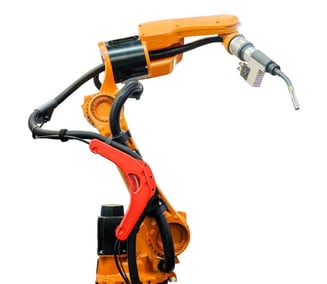By now, you’re likely familiar with the advantages that industrial robot arms have over human workers. When used in repetitive tasks, industrial robots complete their operations without breaks, mistakes, or injuries caused by those repetitive movements. Moreover, they help to improve quality and consistency, all the while boosting production output.

While this might appear to be a “slam dunk” in favor of purchasing an industrial robot arm, the decision to buy one does not differ from any other piece of equipment, requiring an analysis of the costs and benefits first.
Some factors in the analysis should include the initial cost of the robot arm and its installation. Also, consider the programming, integration with existing machines, and maintenance expenses. Finally, you need to determine which type of robot arm is right for your operation—collaborative or traditional models.
Here is what you should know:
The difference between collaborative and traditional robot arms

If you’re beginning the journey toward robotics, it’s helpful to have an understanding of both options. However, in the last year or so, the differences between the two have become more nuanced thanks to advancements in technology. For example, traditional, industrial robot arms could not have close interaction with human workers. But now, with the correct sensors, they can work side-by-side.
The decision is really case dependent, and something an integrator will be able to walk you through to help you pin point the type of robot that would be best for your needs and operations.
Calculating the return on investment (ROI) for an industrial robot arm
If you’re planning to automate with robots, it’s essential to establish the value of automation for your specific business. Some companies calculate ROI using a payback period derived from the cost of the machine divided by the monthly wages of a worker. This method will typically result in a payback period of 6 to 18 months.
However, a more comprehensive calculation considers the short- and long-term benefits—both tangible and intangible—from an investment in robot automation. Here are three examples to consider:
How would the increased productivity help your business?
Consider the ongoing health and safety benefits to your workers after you automate manual and repetitive tasks. Your employees will be available to work on more exciting projects, contributing to their wellbeing and safety. In addition, the shorter turnaround time for your products will make your customers happy, and you can take on more business, which could boost your bottom line.
How much could you save on employee-related expenses?
Consider how much you could save in health, medical, and insurance costs after integrating robots into work systems. Robotics and automation improve ergonomics and worker safety while providing opportunities for employees to learn new technology skills and increase job satisfaction. That can have a positive impact on recruitment and training expenses.
Finally, because many robotic systems are designed to be user friendly and easy to program, companies may be able to save on ongoing engineering costs.
How much would production stability save you over time?
Automating with robots typically results in fewer mistakes due to repetition or worker fatigue, and can reduce quality issues. This may cut down on time spent reworking parts and material costs associated with scrap. In addition, consistency in part quality may boost customer retention and loyalty.
Let the experts help you weigh the costs and benefits
The pros at Force Design can guide you in the right direction. With over 20 years of automation experience, we can help you get started by considering your unique business requirements. We are specialists in robotic applications and industrial automation.
Connect with us today or give us a call at 937-473-3737.



